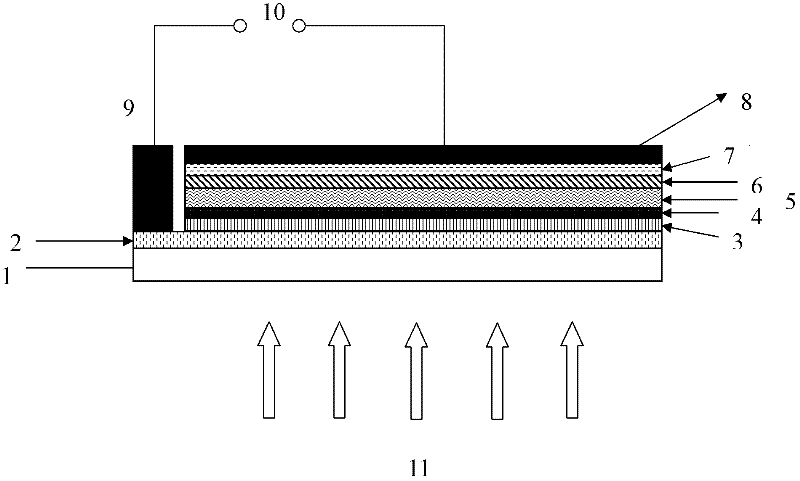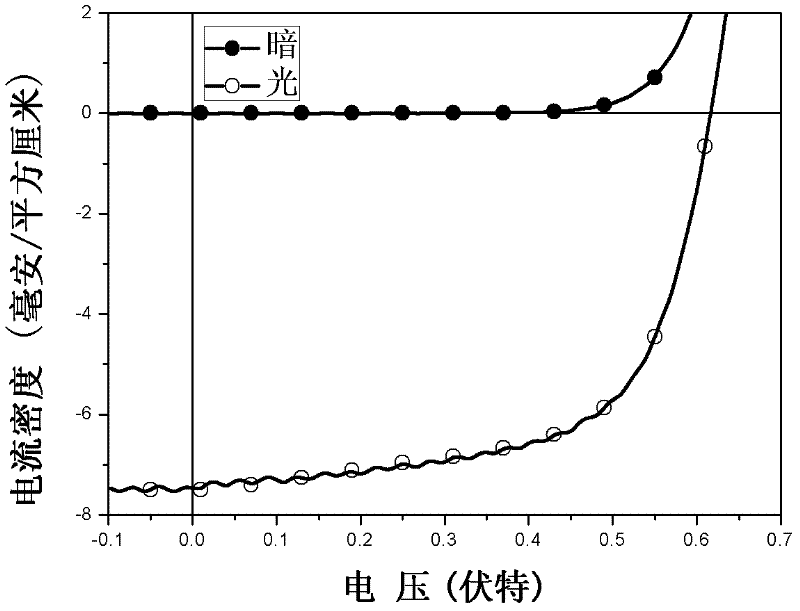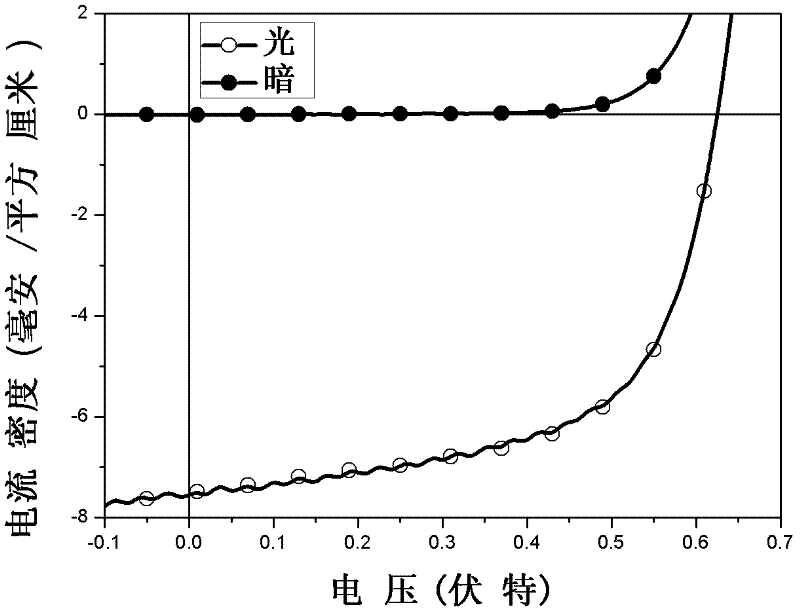P-I-N type polymer solar cell and preparation method thereof
A P-I-N, solar cell technology, applied in the field of polymer solar cells, can solve the problems of no anti-solvent, can not achieve reduction of carrier recombination, etc., to reduce recombination, improve anti-solvent performance, and good experimental repeatability Effect
- Summary
- Abstract
- Description
- Claims
- Application Information
AI Technical Summary
Problems solved by technology
Method used
Image
Examples
Embodiment 1
[0034] Embodiment 1 (comparative example of embodiment 3)
[0035] The transparent conductive glass sputtered with indium tin oxide (ITO) was ultrasonically cleaned with detergent, deionized water, acetone, and isopropanol in sequence, dried with nitrogen, and spin-coated with PEDOT:PSS aqueous solution at 2000 rpm, 150 ° C Bake for 15 minutes and cool naturally to obtain an anodic finishing layer. Combine 10mg / mL of P088 with PC 60 A mixed solution of BM 1:1.3 (mass ratio) (dropped with 3% additive 1-8 diiodooctane) was directly spin-coated on the above-mentioned anode modification layer at a rotational speed of 1500 rpm, as a photoelectric active layer. Then at 4×10 -4 20nm of calcium and 100nm of aluminum were vacuum-evaporated under Pa as the cathode electrode. figure 2 The current-voltage curves of the device without light irradiation and with simulated sunlight irradiation of 100 mW / cm2 are given. The prepared device has an open circuit voltage of 0.620 volts, a sho...
Embodiment 2
[0036] Embodiment 2 (comparative example of embodiment 4)
[0037] The transparent conductive glass sputtered with indium tin oxide (ITO) was ultrasonically cleaned with detergent, deionized water, acetone, and isopropanol in sequence, dried with nitrogen, and spin-coated with PEDOT:PSS aqueous solution at 2000 rpm, 150°C Bake for 15 minutes and cool naturally to obtain an anodic finishing layer. Combine 10mg / mL of P088 with PC 70A mixed solution of BM 1:1.3 (mass ratio) (dropped with 3% additive 1-8 diiodooctane) was directly spin-coated on the above-mentioned hole collection layer at a rotational speed of 1500 rpm, as a photoelectric active layer. Then at 4×10 -4 20nm of calcium and 100nm of aluminum were vacuum-deposited under pa as the cathode. image 3 The current-voltage curves of the device without light irradiation and with simulated sunlight irradiation of 100 mW / cm2 are given. The prepared device has an open-circuit voltage of 0.630 volts, a short-circuit current...
Embodiment 3
[0039] The transparent conductive glass sputtered with indium tin oxide (ITO) was ultrasonically cleaned with detergent, deionized water, acetone, and isopropanol in sequence, dried with nitrogen, and spin-coated with PEDOT:PSS aqueous solution at 2000 rpm, 150 ° C Bake for 15 minutes and cool naturally to obtain an anodic finishing layer. Then 12mg / mL P088 solution was spin-coated on it at 4000rpm, baked at 150°C for 10min, then irradiated with ultraviolet light for 2min, and then 10mg / mL of P088 was mixed with PC 60 A mixed solution of BM 1:1.3 (mass ratio) (with 3% additive 1-8 diiodooctane added dropwise) was spin-coated thereon at a rotational speed of 1500 rpm, as a photoelectric active layer. Then at 4×10 -4 20nm of calcium and 100nm of aluminum were vacuum-evaporated under Pa as the cathode. Figure 4 The current-voltage curves of the device without light irradiation and with simulated sunlight irradiation of 100 mW / cm2 are given. The prepared device has an open cir...
PUM
 Login to View More
Login to View More Abstract
Description
Claims
Application Information
 Login to View More
Login to View More - R&D
- Intellectual Property
- Life Sciences
- Materials
- Tech Scout
- Unparalleled Data Quality
- Higher Quality Content
- 60% Fewer Hallucinations
Browse by: Latest US Patents, China's latest patents, Technical Efficacy Thesaurus, Application Domain, Technology Topic, Popular Technical Reports.
© 2025 PatSnap. All rights reserved.Legal|Privacy policy|Modern Slavery Act Transparency Statement|Sitemap|About US| Contact US: help@patsnap.com



